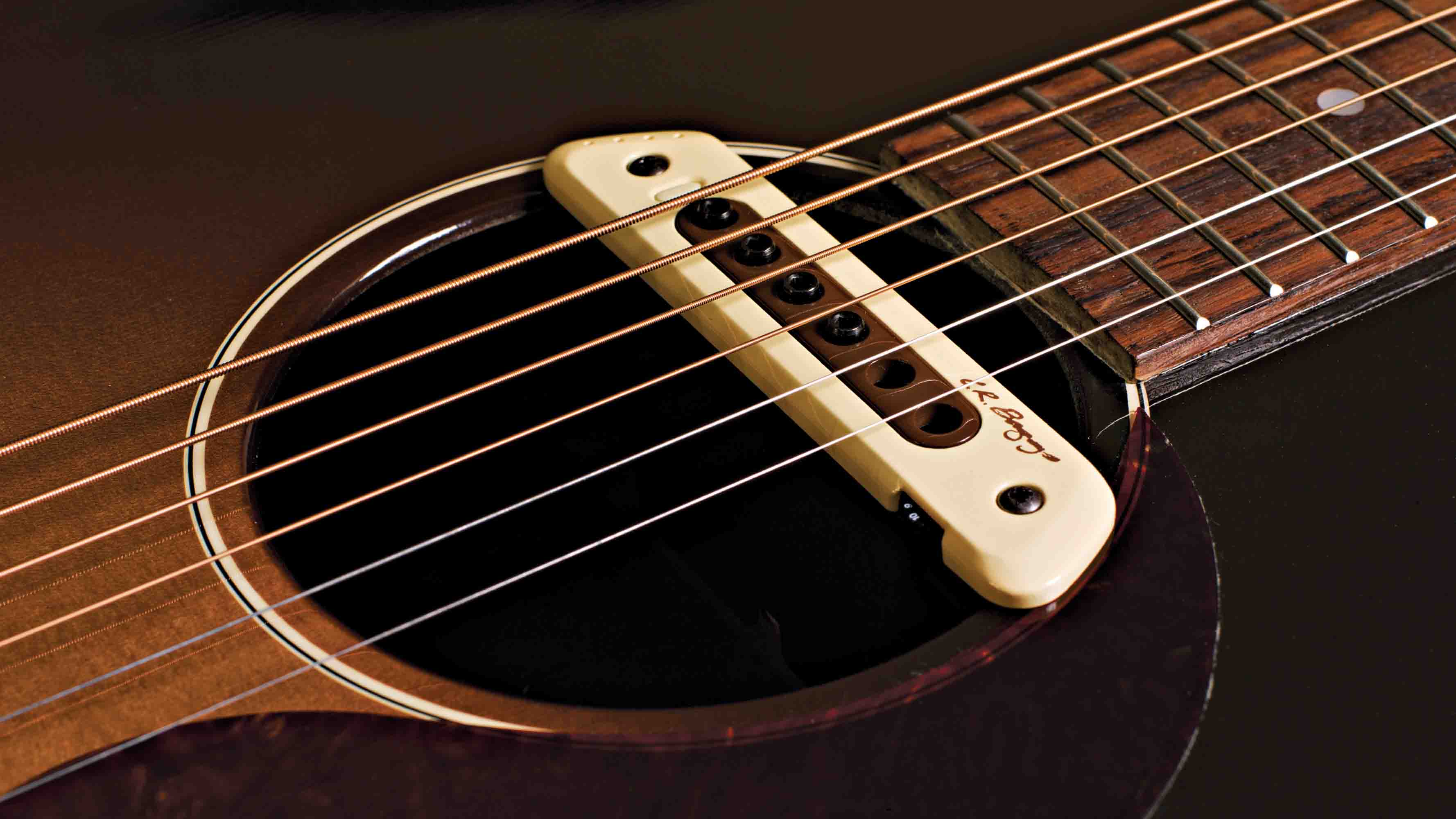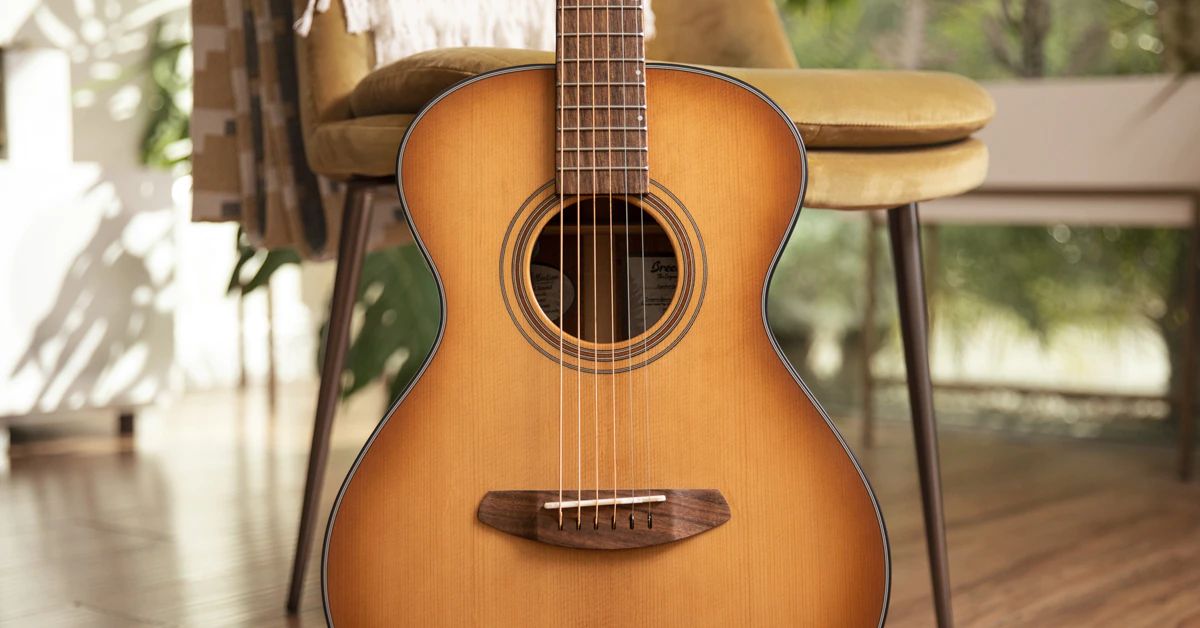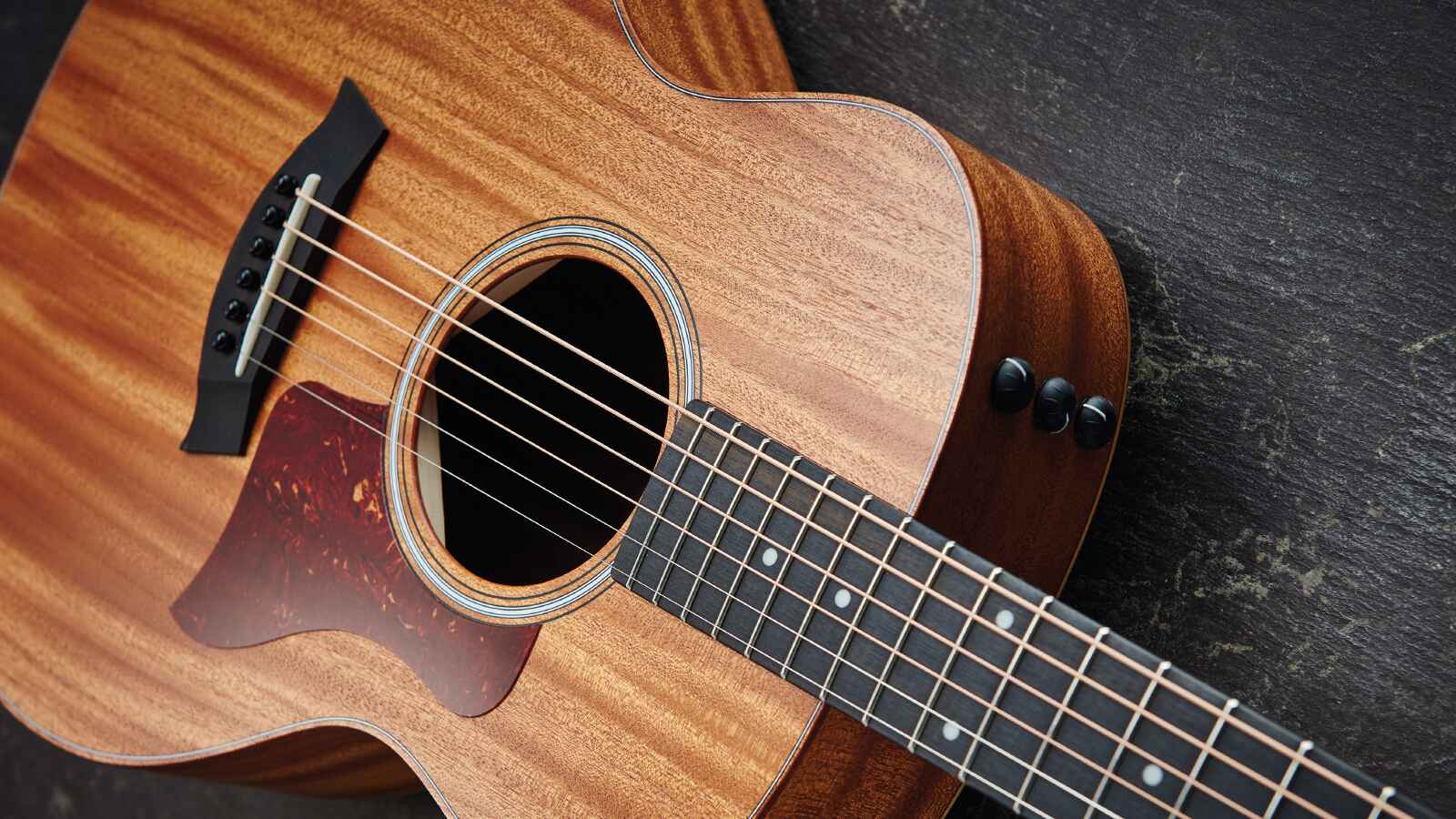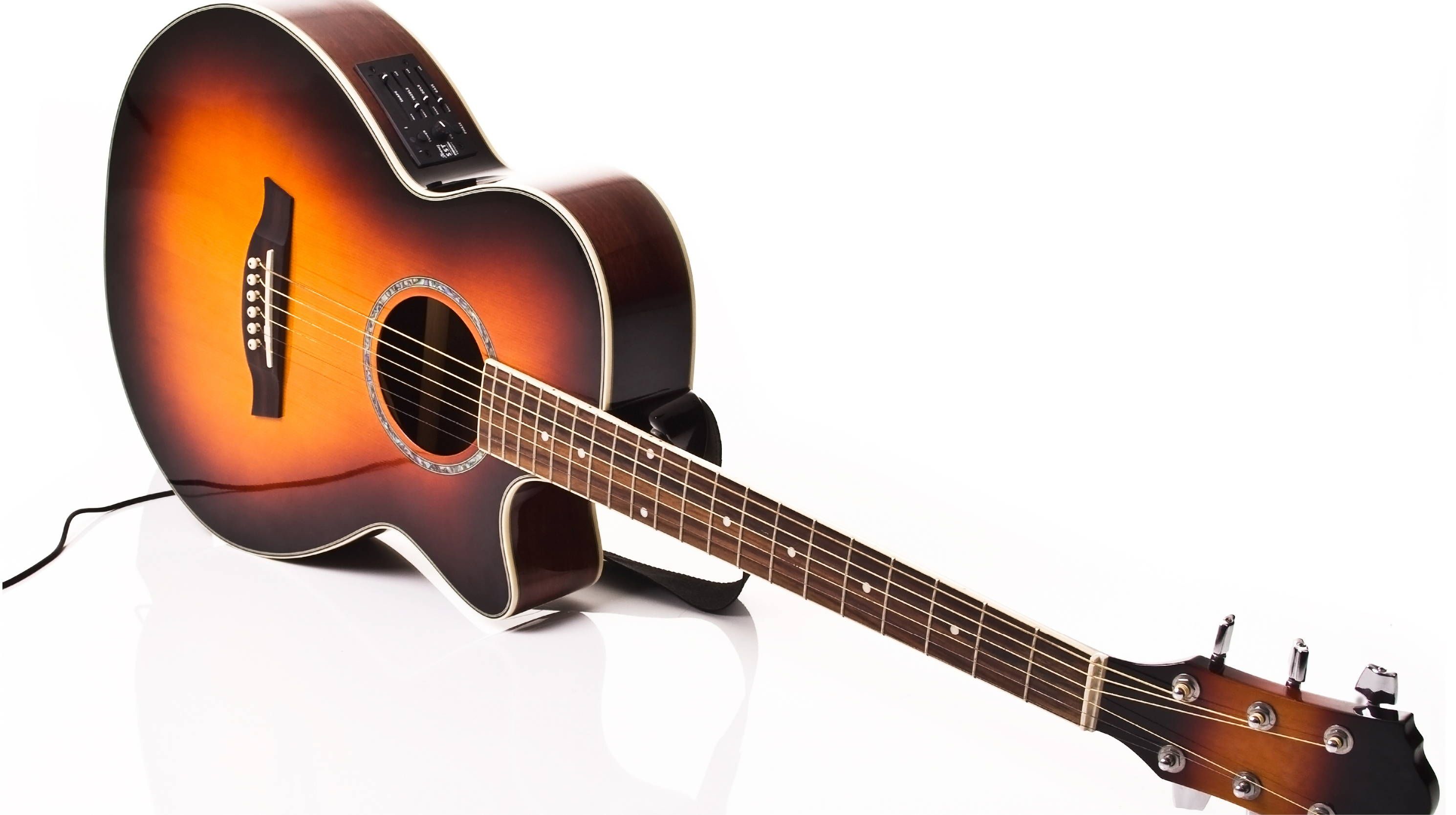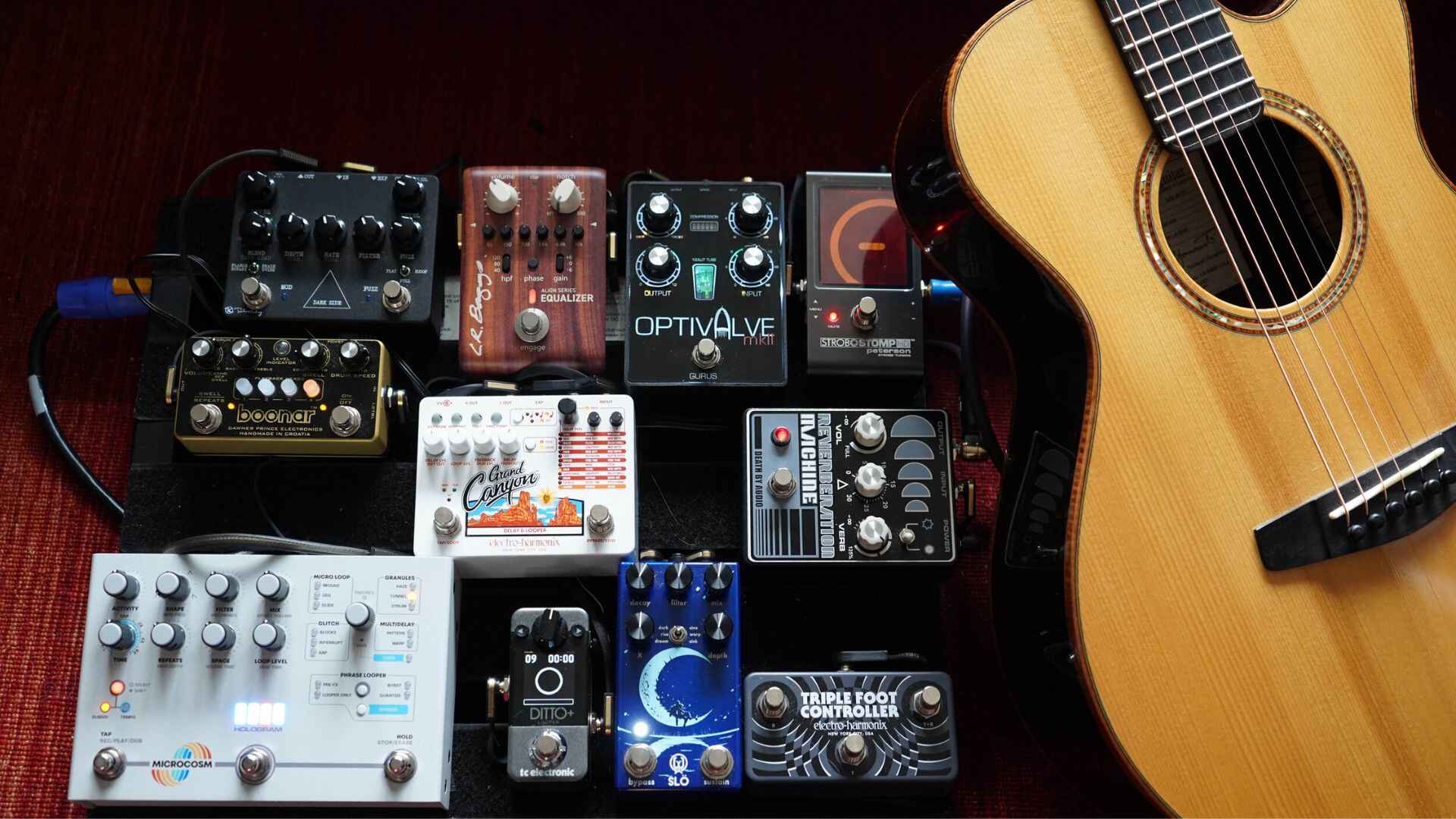The Anatomy of an Acoustic Guitar
An acoustic guitar is a beautifully crafted instrument with a complex anatomy that contributes to its unique sound and playability. Understanding the different components of an acoustic guitar is essential for any player or enthusiast. Let’s explore the various parts that make up this musical marvel:
1. Soundboard: Also known as the top, the soundboard is the front face of the guitar body. It is usually made of spruce or cedar and is responsible for transmitting the vibrations from the strings to produce sound.
2. Soundhole: Found on the soundboard, the soundhole acts as a portal for soundwaves to escape and resonate. It helps to increase the volume and projection of the guitar.
3. Bridge and Saddle: The bridge, usually made of wood, holds the strings in place on the body. The saddle, located on the bridge, helps transmit the vibrations from the strings to the soundboard, further enhancing the guitar’s tone.
4. Strings: Perhaps the most crucial part of the guitar, the strings are responsible for producing sound. They are made of steel or nylon and are plucked or strummed to create musical notes.
5. Soundbox: The body of the guitar, also known as the soundbox or resonator, serves as an acoustic amplifier. Its shape, size, and material (usually wood) contribute to the sound’s resonance, volume, and tonal characteristics.
6. Neck and Fretboard: The neck connects the body to the headstock and holds the fretboard. It provides support for the strings and allows players to navigate the frets to produce different notes and chords.
7. Nut: Located on the joint between the headstock and the neck, the nut is a small piece usually made of bone or synthetic material. It helps maintain string spacing and height, ensuring clear and defined sound.
8. Tuning Pegs: These small cylindrical parts are found on the headstock and are used to adjust the tension of each string. Tuning pegs allow players to tune the guitar to the desired pitch.
9. Variants: Acoustic guitars can come in various shapes and sizes, such as dreadnought, jumbo, concert, or parlor, each with its unique qualities and tonal characteristics.
Understanding the anatomy of an acoustic guitar allows players to not only appreciate the craftsmanship behind it but also make informed decisions when selecting a guitar that suits their playing style and preferences. By exploring the different components and their functions, you can develop a deeper understanding of the instrument that will enhance your playing experience.
The Soundboard: Creating Vibrations
The soundboard, also known as the top, is a crucial component of an acoustic guitar. It is responsible for creating vibrations that ultimately produce the beautiful tones we hear. Let’s take a closer look at how the soundboard functions and its significance in shaping the guitar’s sound.
The soundboard is typically made of spruce or cedar, chosen for their acoustic properties. These woods are known for their ability to resonate and produce rich, vibrant tones. The soundboard is carefully crafted to be thin yet sturdy, allowing it to vibrate freely while maintaining structural integrity.
When you pluck or strum the guitar strings, the vibrations travel through the bridge and saddle, which are directly coupled to the soundboard. As the strings vibrate, they transfer energy to the soundboard, causing it to vibrate in a similar pattern. This creates a sympathetic resonance, amplifying the sound and projecting it outward.
The vibrations on the soundboard create intricate patterns, known as standing waves or modes. These modes determine the characteristic frequencies and tonal qualities produced by the guitar. The shape and bracing of the soundboard also play a critical role in shaping the instrument’s sound.
The soundhole, located on the soundboard, plays a vital role in the guitar’s sound projection. It serves as an opening that allows the soundwaves to escape, preventing dampening and increasing the volume and resonance of the instrument. Additionally, the size and shape of the soundhole can affect the guitar’s tone, with larger soundholes often producing a more robust and open sound.
Another important aspect of the soundboard is the bracing. Bracing consists of wooden struts or braces strategically placed underneath the soundboard to add strength and control the vibrations. The bracing pattern can vary depending on the guitar’s design, and it significantly influences the instrument’s tonal characteristics, such as sustain, responsiveness, and balance between the low and high frequencies.
The soundboard’s ability to create and transmit vibrations is essential for the guitar’s overall tone and projection. The selection of high-quality wood, construction techniques, and bracing patterns all impact the sound produced by the instrument.
By understanding the function and significance of the soundboard, guitar players can appreciate the intricate craftsmanship and design that goes into creating an acoustic guitar with exceptional sound and playability.
The Role of the Soundhole
The soundhole is a vital component of an acoustic guitar that plays a crucial role in shaping its sound. Let’s explore the function and significance of the soundhole in more detail.
Located on the soundboard of the guitar, the soundhole acts as an opening that allows soundwaves to escape. When the guitar’s strings are plucked or strummed, they produce vibrations that transfer to the soundboard. These vibrations create soundwaves that resonate within the instrument’s body. Without an opening, the soundwaves would be trapped inside, resulting in a muffled and subdued sound.
The size and shape of the soundhole greatly impact the guitar’s sound projection and tonal qualities. Larger soundholes tend to produce a louder and more resonant sound, while smaller ones may yield a more focused and intimate tone. The placement of the soundhole is also strategically chosen to optimize the instrument’s sound distribution.
In addition to allowing sound to escape, the soundhole plays a crucial role in the guitar’s overall resonance. As the soundwaves vibrate through the soundboard, they interact with the air inside the guitar body. This interaction creates a resonance chamber, amplifying the sound and enhancing the instrument’s sustain and depth.
Furthermore, the design and placement of the soundhole contribute to the guitar’s aesthetic appeal. Many guitar makers incorporate intricate designs around the soundhole, such as rosettes or decorative inlays, adding an artistic touch to the instrument.
It’s worth noting that the soundhole also affects the guitar’s feedback control. Feedback occurs when amplified sound from the guitar’s soundhole is picked up and re-amplified by an external source, such as a microphone or speaker. Carefully designed soundholes help minimize feedback issues, allowing guitar players to perform at higher volumes without unwanted noise.
Overall, the soundhole is an integral part of an acoustic guitar, serving both functional and aesthetic purposes. It allows soundwaves to escape, enhances the instrument’s resonance, and contributes to its overall tone and projection. Guitar players and enthusiasts can appreciate the importance of the soundhole in shaping the sound and character of acoustic guitars.
The Importance of the Bridge and Saddle
The bridge and saddle are essential components of an acoustic guitar, playing a crucial role in transmitting vibrations from the strings to the soundboard. Let’s explore the significance of the bridge and saddle and their impact on the guitar’s tone and playability.
The bridge is located on the top of the guitar body and serves as an anchor point for the strings. Typically made of wood, such as rosewood or ebony, the bridge is carefully crafted to ensure stability and optimal transfer of vibrations. It is securely attached to the soundboard, allowing the strings’ vibrations to be efficiently transmitted to the instrument’s body.
The saddle, positioned on the bridge, is a small piece that provides a point of contact for the strings. It is usually made of bone, ivory, or synthetic materials. As the strings are plucked or strummed, the vibrations travel through the saddle, transferring energy to the soundboard.
The material and design of the bridge and saddle significantly impact the guitar’s tone. Different types of wood and saddle materials can affect the instrument’s sustain, resonance, and tonal characteristics. For example, a denser saddle material may enhance the guitar’s sustain, while a lighter material may produce a brighter or more mellow tone.
The placement of the saddle also affects the guitar’s intonation, which refers to the accuracy of the instrument’s pitch across the fretboard. Guitar makers carefully position the saddle to ensure proper string length and intonation, allowing players to achieve accurate notes and chords throughout the neck.
Additionally, the bridge and saddle contribute to the guitar’s playability. The height and contour of the saddle can affect the action of the strings, which refers to the distance between the strings and the fretboard. A well-adjusted saddle can provide comfortable string height, facilitating smooth and effortless playing.
Furthermore, the bridge and saddle play a role in the guitar’s stability and structural integrity. The bridge is responsible for distributing string tension across the soundboard, ensuring even pressure and minimizing the risk of damage. The saddle also provides support for the strings and helps maintain proper string spacing, enhancing overall playability and tone.
In summary, the bridge and saddle are critical components of an acoustic guitar. They work hand-in-hand to transmit vibrations from the strings to the soundboard, impacting the guitar’s tone, intonation, and playability. The careful selection of materials, precise positioning, and proper adjustments contribute to an instrument’s overall performance and sound quality.
Understanding the Role of the Strings
Strings are the heart and soul of an acoustic guitar, as they directly produce the sound when plucked or strummed. Let’s delve into the importance of strings and how they influence the guitar’s tone and playability.
Acoustic guitar strings can be made of steel or nylon, each offering its unique characteristics. Steel strings, commonly used in most acoustic guitars, produce a bright and vibrant tone favored by many genres. On the other hand, nylon strings, often found on classical guitars, deliver a warm and mellow sound.
The thickness, or gauge, of the strings also impacts the overall sound. Lighter gauge strings offer a brighter tone with easier playability, making them suitable for fingerpicking and delicate playing. Heavier gauge strings produce a fuller, more robust tone, and are preferred by players who require a more powerful sound or play with a heavier touch.
String tension is another crucial factor that affects the guitar’s playability. High tension strings offer a firm feel and produce more volume and sustain. Low tension strings, on the other hand, provide a more relaxed playing experience, making them ideal for players who prefer a lighter touch.
It’s important to consider the type of strings that best suit your playing style and desired sound. Experimenting with different brands, materials, gauges, and tensions can help you discover the perfect set of strings to achieve your desired tone.
Regular maintenance and replacement of strings are necessary to maintain optimal sound quality. Over time, strings can become worn and lose their brightness and elasticity. Changing them regularly helps ensure consistency in tone and playability.
String height, or action, also impacts how the guitar feels and plays. Higher action requires more finger strength but allows for greater sustain and resonance. Lower action is easier to play but may sacrifice sustain and cause buzzing if not properly adjusted.
Proper string care and maintenance are essential to prolong their lifespan. Keeping them clean and lubricated can help prevent corrosion and prolong the strings’ playability and tonal quality.
In summary, strings are a fundamental element of an acoustic guitar, directly influencing its tone, playability, and overall sound. Choosing the right type, gauge, and tension of strings, along with regular maintenance, is essential for achieving the desired sound and ensuring an enjoyable playing experience.
The Soundbox: Amplifying the Sound
The soundbox, also known as the body or resonator, is a crucial component of an acoustic guitar. It serves as an acoustic amplifier, enhancing and projecting the sound produced by the strings and the soundboard. Let’s explore the significance of the soundbox and its role in amplifying the guitar’s sound.
The soundbox consists of the back, sides, and soundboard of the guitar. These components, typically made of wood, contribute to the instrument’s resonance, volume, and tonal qualities.
When the guitar strings are plucked or strummed, they create vibrations that are transferred to the soundboard through the bridge and saddle. The soundboard vibrates in response, and these vibrations are amplified within the cavity of the soundbox.
The soundbox acts as a resonating chamber, allowing the vibrations to bounce around and interact with the air inside. This interaction amplifies the sound produced by the strings and the soundboard, resulting in a louder and more vibrant tone.
The shape and size of the soundbox play a significant role in the guitar’s sound projection and tonal characteristics. Different body shapes, such as dreadnought, concert, or jumbo, have distinct tonal qualities and volume levels. The curvature and contours of the soundbox also contribute to the overall resonance and balance of the instrument.
The choice of wood for the soundbox is paramount in shaping the guitar’s tone. Different types of wood, such as mahogany, rosewood, or maple, offer distinct tonal properties, including warmth, richness, brightness, or clarity. The combination of the soundboard and the back and sides determines the guitar’s unique sonic signature.
Furthermore, the soundbox contributes to the sustain and decay of the guitar’s notes. The resonating cavity allows the sound to linger and gradually fade away, adding depth and character to the instrument’s sound.
While the soundboard is responsible for creating vibrations, the soundbox serves to optimize and amplify those vibrations, transforming them into audible sound. Without a properly crafted soundbox, the acoustic guitar’s sound would be significantly diminished.
In addition to its functional significance, the soundbox is often an aesthetic focal point. The craftsmanship and design of the guitar’s body can feature intricate inlays, bindings, or finishes, making it visually appealing to the player and the audience.
Ultimately, the soundbox acts as a natural amplifier, shaping and projecting the sound produced by the strings and soundboard. The combination of its size, shape, wood selection, and craftsmanship significantly influences the guitar’s tonal qualities, volume, and overall sound characteristics.
The Impact of the Neck and Fretboard
The neck and fretboard of an acoustic guitar play a significant role in both the instrument’s playability and the sound it produces. Let’s explore the impact of the neck and fretboard and their importance in the overall guitar experience.
The neck of the guitar provides structural support and holds the fretboard in place. It is usually made of wood, such as mahogany or maple, chosen for its strength and stability. The shape and contour of the neck greatly influence the player’s comfort and ability to navigate the frets.
The profile of the neck refers to its shape in cross-section, ranging from a flat and thin “C” shape to a more rounded and thicker “D” shape. This aspect is a matter of personal preference, with players choosing the profile that feels most comfortable in their hands. Some neck profiles provide more stability, while others offer a faster playing experience.
The fretboard, often made of rosewood or ebony, sits on top of the neck and is where the player’s fingers press down on the strings to produce different notes and chords. The fretboard’s smooth surface and careful fret placement are crucial for precise intonation and accurate playing.
The width and radius of the fretboard also affect playability. A wider fretboard provides more space between strings, ideal for fingerstyle playing, while a narrower one suits players with smaller hands or those who prefer a closer string spacing. The fretboard’s radius, the curvature from side to side, affects how easily players can bend strings or perform complex chords.
Furthermore, the neck angle and the action of the strings, determined by the height of the strings above the fretboard, greatly impact the guitar’s playability. A well-aligned neck angle and properly adjusted action ensure comfortable fretting and facilitate smooth string bending and vibrato techniques.
The materials used for the neck and fretboard also contribute to the guitar’s tone. Different types of wood can impart their unique tonal characteristics to the instrument. For example, rosewood is known for adding warmth and depth to the overall sound, while maple can lend brightness and clarity.
The neck and fretboard play a crucial role in the playability and sound of an acoustic guitar. A well-crafted and properly adjusted neck allows for comfortable and precise playing, ensuring that players can easily navigate the instrument. Additionally, the materials used and the design choices can contribute to the guitar’s tonal qualities, adding character and nuance to its sound.
The Nut: Clarity in Sound
The nut is a small yet essential component of an acoustic guitar that plays a significant role in the instrument’s sound and overall playability. Let’s explore the importance of the nut and how it contributes to the clarity of the guitar’s sound.
The nut is a small piece, usually made of bone, synthetic materials, or even metal, located at the joint where the headstock meets the neck. It serves as a guide for the strings, keeping them evenly spaced and elevated above the fretboard.
One of the primary functions of the nut is to maintain proper string spacing, ensuring that each string has the appropriate distance from its neighboring strings. This allows for accurate finger placement and prevents unintentional muting or buzzing of adjacent strings during playing.
Another critical role of the nut is to determine the string height, also known as the action, at the guitar’s first fret. A properly filed and adjusted nut allows for a comfortable and controlled playing experience, as the strings are not too high or too low above the fretboard. This helps to prevent fret buzz and allows for clear and precise notes across the fretboard.
The material used for the nut can also impact the guitar’s sound. Commonly, bone is favored for its tonal properties and ability to transmit vibrations from the strings to the neck, resulting in enhanced sustain and clarity. However, synthetic materials, such as Tusq or graphite, can offer similar tonal qualities and increased durability.
Additionally, the nut’s slots must be properly cut to accommodate the strings. The slots should be deep enough to hold the strings firmly in place but not too deep that they impede the strings’ vibration. Precise and well-cut nut slots contribute to better tuning stability and sustain, as they allow the strings to freely resonate and transfer energy to the guitar body.
The nut is also a critical component for accurate tuning. Tightening or loosening the strings at the tuning pegs causes the strings to exert pressure and friction at the nut. A well-lubricated nut reduces binding and allows for smooth tuning adjustments, improving the overall tuning stability of the guitar.
In summary, while often overlooked, the nut is a vital aspect of an acoustic guitar’s setup. It ensures proper string spacing, string height, tuning stability, and contributes to the clarity of the instrument’s sound. A well-crafted and properly adjusted nut enhances the playability and overall performance of the guitar, allowing for clear and precise notes across the fretboard.
Tuning Pegs and Their Function
Tuning pegs, also known as machine heads or tuners, are the small cylindrical parts found on the headstock of an acoustic guitar. They play a crucial role in adjusting and maintaining the tension of each string, which determines the guitar’s tuning. Let’s explore the function and significance of tuning pegs in more detail.
The primary function of tuning pegs is to hold the strings in place on the headstock and allow for precise and accurate tuning. When you turn the tuning pegs, it either tightens or loosens the corresponding string’s tension, resulting in a higher or lower pitch.
Tuning pegs consist of a rotating metal shaft with gear-like teeth, which engages with a worm gear inside the headstock. This mechanism allows for fine adjustments to the string tension with each turn of the peg.
Tuning pegs come in different designs, including open gear, enclosed or sealed gear, and locking mechanisms. Each type offers its advantages in terms of stability, precision, and ease of use.
Ensuring that the tuning pegs are properly fitted and function smoothly is essential for consistent and reliable tuning. Loose or worn-out tuning pegs can result in tuning instability, causing the strings to go out of tune more frequently.
Some higher-end acoustic guitars may feature more advanced tuning systems, such as locking tuners or planetary gears, which provide additional stability and ease of string changes. These systems eliminate the need for multiple string wraps around the tuning pegs, ensuring that the strings maintain their tension and tuning integrity even during aggressive playing or heavy bending.
Regular maintenance of the tuning pegs is crucial to their optimal function. Periodically lubricating the pegs with a small amount of graphite or specialized lubricant helps reduce friction and ensures smooth operation.
Aside from their functional significance, tuning pegs also contribute to the overall aesthetics of the guitar. Many guitars feature beautifully designed and intricately crafted tuning pegs, adding an extra touch of visual appeal.
Overall, tuning pegs are an essential component of an acoustic guitar, allowing for precise tuning adjustments and maintaining the desired tension of each string. Properly functioning tuning pegs contribute to tuning stability, playability, and ultimately, the overall enjoyment and performance of the instrument.
How Acoustic Guitars Produce Different Tones
Acoustic guitars are versatile instruments capable of producing a wide range of tones and sounds. The distinctive tonal qualities of acoustic guitars are influenced by various factors, including the guitar’s construction, materials, and playing technique. Let’s explore how acoustic guitars produce different tones.
1. Body Shape and Size: The shape and size of the guitar’s body significantly impact its tone. Different body shapes, such as dreadnought, concert, or jumbo, offer distinct tonal characteristics. Larger bodies tend to produce more volume and richer bass response, while smaller bodies generally have a more focused and balanced sound.
2. Woods Used: The choice of wood for the guitar’s top (soundboard), back, and sides greatly affects the tone. Woods like spruce, cedar, mahogany, and rosewood have variations in tonality, with spruce often providing brightness and clarity, and mahogany offering warmth and midrange emphasis.
3. Bracing: The internal bracing of the guitar contributes to the instrument’s tone. Bracing patterns can vary, influencing the guitar’s resonance, sustain, and tonal projection. Different bracing designs emphasize different tonal qualities, such as enhanced bass response or increased treble presence.
4. Strings: The type and gauge of strings used on an acoustic guitar can dramatically alter its tone. Steel strings offer a bright and vibrant sound, while nylon strings produce a warm and mellow tone. Variations in string gauge can impact volume, tonal richness, and playability.
5. Playing Technique: How a guitarist strikes or plucks the strings greatly affects the tone production. Altering the point of contact on the strings, using different strumming patterns, fingerpicking, or employing techniques like palm muting, harmonics, or slides can all generate a wide array of tonal variations.
6. Fingerstyle vs. Strumming: Fingerstyle playing and strumming produce different tonal textures. Fingerstyle techniques allow for more control over individual note articulation and dynamics, resulting in a more nuanced and intricate tone. Strumming, on the other hand, emphasizes the harmonics and overtones produced by multiple strings at once, leading to a fuller and more vibrant sound.
7. Effects and Amplification: The use of effects pedals and amplification can also shape the guitar’s tone. Different effects, such as reverb, distortion, or chorus, can add depth, sustain, or altered timbres to the acoustic guitar’s sound. Amplification allows for increased volume and further tonal manipulation.
8. Age and Playing Wear: Over time, acoustic guitars develop unique tonal qualities as they age and mature. The wood’s density and resonant properties change, resulting in a warmer and more resonant tone. Similarly, playing the guitar regularly causes the wood to vibrate and open up, further enhancing its tonal complexity.
By considering these factors that influence tone production, guitarists can explore and experiment with different combinations to achieve the desired sound and tonal characteristics on their acoustic guitars.
Maintenance Tips for Your Acoustic Guitar
Regular maintenance is essential for keeping your acoustic guitar in optimal playing condition and preserving its tone and longevity. Here are some important maintenance tips to help you care for your instrument:
1. Cleaning: Wipe down your guitar after each playing session to remove oils, sweat, and dirt that can accumulate on the body, neck, and strings. Use a soft, lint-free cloth to avoid scratching the finish.
2. String Care: Clean your strings with a string cleaner or a cloth to remove dirt and debris that can accumulate between the windings. This helps to prolong their lifespan and maintain their tone.
3. Humidity Control: Acoustic guitars are sensitive to changes in humidity, which can cause the wood to expand or contract. Use a humidifier inside the guitar’s case to maintain a stable humidity level, especially in dry environments.
4. Tuning Stability: Regularly check and tune your guitar to ensure proper pitch and intonation. Inspect the tuning pegs for any signs of wear or slipping, and replace them if necessary.
5. Action and Neck Relief: Monitor the action (string height) and neck relief of your guitar. If the strings are too high or too low, or if you notice excessive bowing or backbow in the neck, consult a professional for adjustments.
6. Fretboard Conditioning: Apply a small amount of fretboard conditioner, such as lemon oil, to keep the fretboard moisturized and prevent drying and cracking. Wipe off any excess oil to avoid buildup.
7. Nut and Saddle Maintenance: Periodically inspect the nut and saddle for any signs of wear or damage. Ensure that the nut slots are properly lubricated and that the strings are seated securely. If necessary, consult a professional to address any issues.
8. Storage and Protection: When not in use, store your guitar in a suitable case to protect it from dust, humidity, and potential accidents. Avoid exposing it to extreme temperatures or direct sunlight, as these can damage the finish and affect the wood.
9. Regular Checkups: Consider having your guitar professionally set up and inspected at least once a year or as needed. A qualified guitar technician can assess the instrument’s condition, address any potential problems, and make necessary adjustments for optimal playability.
Remember, proper maintenance and care not only preserve the appearance and playability of your acoustic guitar but also contribute to the longevity and overall enjoyment of your instrument. Treat your guitar with care, and it will reward you with beautiful tones and years of playing pleasure.
Exploring Acoustic Guitar Variants
Acoustic guitars come in various shapes and sizes, each with its unique qualities and tonal characteristics. Let’s explore some of the most common acoustic guitar variants:
1. Dreadnought: The dreadnought is one of the most popular and recognizable acoustic guitar shapes. It features a large, square-shouldered body, imparting a rich and powerful sound. Dreadnought guitars are known for their versatility, making them suitable for a wide range of musical styles.
2. Concert and Auditorium: Concert and auditorium guitars are slightly smaller than dreadnoughts, offering a well-balanced tone with a focused midrange. These guitars are comfortable to play and are popular choices for fingerstyle and folk genres.
3. Jumbo: Jumbo guitars have a large, rounded body shape, providing a booming bass response and a robust overall sound. They excel in producing volume and projection, making them ideal for strumming and rhythm playing.
4. Parlor: Parlor guitars have a compact and intimate design, reminiscent of guitars from the late 19th and early 20th centuries. They offer a sweet, warm tone and are favored by blues and folk players for their portability and vintage charm.
5. Travel and Mini: Travel and mini guitars are designed for their compact size and portability. These guitars are perfect for musicians on the go or those with smaller hands. Despite their size, they offer surprisingly decent tone and playability.
6. 12-String: 12-string guitars feature paired strings for each of the six traditional guitar strings. This doubling of strings creates a rich, chorus-like effect, producing a fuller and shimmering sound. 12-string guitars are commonly used in folk, rock, and country music.
7. Nylon-String (Classical): Nylon-string guitars, also known as classical guitars, feature a wider neck and nylon strings. They produce a mellow and warm tone, ideal for classical, flamenco, and fingerstyle playing.
8. Baritone: Baritone guitars have a longer scale length and lower tuning, creating a deep and resonant sound. They are often used in genres that require a darker and more bass-centric tone, such as jazz, folk, or blues.
9. Resonator: Resonator guitars have a unique construction with a metal resonator cone that amplifies the sound. They have a distinct twang and bright tone, often associated with blues, bluegrass, and slide guitar playing.
Each acoustic guitar variant offers its own sonic qualities and suitability for different playing styles and genres. Exploring these variations allows musicians to find the perfect instrument that matches their tonal preferences and musical aspirations.










